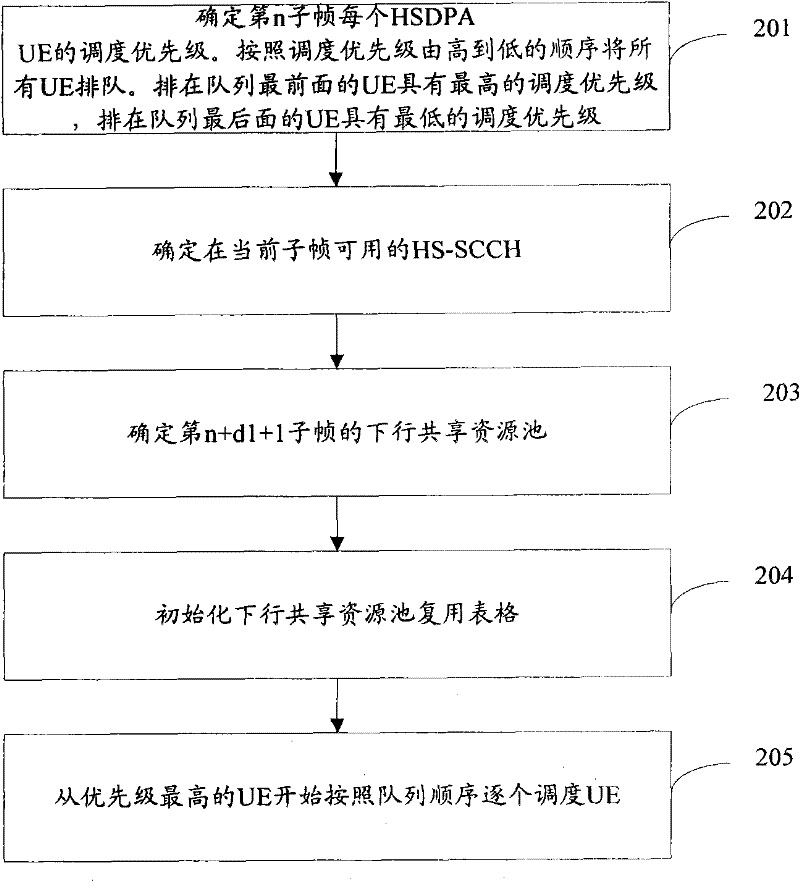HSDPA scheduler and scheduling method employing MU MIMO technology
A scheduler and technology technology, applied in the directions of space transmit diversity, electrical components, diversity/multi-antenna systems, etc., can solve problems such as UE cannot be multiplexed
- Summary
- Abstract
- Description
- Claims
- Application Information
AI Technical Summary
Problems solved by technology
Method used
Image
Examples
Embodiment 1
[0158] This embodiment will propose the first HSDPA scheduler and scheduling method. The scheduler and scheduling method can not only implement HSDPA UE to multiplex and schedule HS-PDSCH resources in MU MIMO mode, but also realize HSDPA UE to multiplex any one of the above-mentioned channels of the first type and the third type in the form of MU MIMO. downlink resources. With the scheduler and scheduling method, the scheduling of each subframe is independent of each other. The scheduling scheme first determines the combination of channel types other than HS-PDSCH that can be multiplexed by the HSDPA UE, and then the HSDPA scheduler starts periodic scheduling. In any subsequent subframe, the HSDPA scheduler performs HSDPA scheduling once.
[0159] The scheduler can pre-configure the correspondence table of application scenarios and channel type combinations. In the correspondence table, each application scenario corresponds to a specific channel type combination. Of course, ...
Embodiment 2
[0227] In practical applications, there are the following scenarios:
[0228] Resource multiplexing is not used between HSDPA UEs, but HSDPA UEs are supported to multiplex resources included in any channel combination composed of the above-mentioned first type and third type downlink channels.
[0229] Since the resource multiplexing between HSDPA UEs is not supported, the scheduler and scheduling method in this scenario have nothing to do with the existing MU MIMO technology. At the same time, the scheduler and scheduling method in this scenario extend the application of the MU MIMO technology proposed by the present invention to scheduling other downlink resources besides HS-PDSCH into: HSDPA UE can multiplex resources of other downlink channels. Here, the downlink channel refers to the first type of downlink channel and the third type of downlink channel.
[0230] The scheduler and scheduling method in the above scenario are special cases of the scheduler and scheduling me...
Embodiment 3
[0273] Embodiment 3 is used to introduce an example when HSDPA UEs do not support multiplexing resources and only support HSDPA UEs to multiplex downlink idle resources. This example can be regarded as Embodiment 2 when multiplexed resource types only include idle downlink resources. variant embodiment. Therefore, this embodiment is essentially irrelevant to the existing MU MIMO technology.
[0274] The HSDPA scheduler starts periodic scheduling. In any subsequent subframe "n", the HSDPA scheduler performs HSDPA scheduling once.
[0275] In any subframe "n", the scheduling process of the HSDPA scheduler is as follows Image 6 shown, including the following steps:
[0276] Step 401: Determine the scheduling priority of each HSDPA UE in the "n"th subframe. All UEs are queued in descending order of scheduling priority. The UE at the top of the queue has the highest scheduling priority, and the UE at the bottom of the queue has the lowest scheduling priority.
[0277] Step 4...
PUM
 Login to View More
Login to View More Abstract
Description
Claims
Application Information
 Login to View More
Login to View More - R&D
- Intellectual Property
- Life Sciences
- Materials
- Tech Scout
- Unparalleled Data Quality
- Higher Quality Content
- 60% Fewer Hallucinations
Browse by: Latest US Patents, China's latest patents, Technical Efficacy Thesaurus, Application Domain, Technology Topic, Popular Technical Reports.
© 2025 PatSnap. All rights reserved.Legal|Privacy policy|Modern Slavery Act Transparency Statement|Sitemap|About US| Contact US: help@patsnap.com



